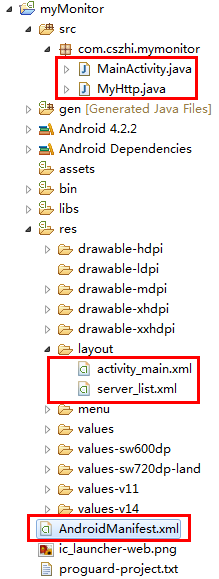开发自己的监控系统三、移动篇(android)
开发自己的监控系统一、email篇
开发自己的监控系统二、web篇
移动篇(android)
关键字:java、android、json、php
互联网已经进入大数据时代,如果没有给自己的产品开发手机端的应用程序,出门都不好意思跟别人打招呼了~~
为了随时随地掌握服务器的运行状态,当然,也为了装ability,下面就来为我们的监控系统开发一个手机端(android)的应用。
原理:
首先编写一个web接口,读取数据库服务器数据,返回json对象数组。android应用程序解析json数据,通过listvie控件显示。
以下是web接口,php编写,pdo方式连接数据库,使用json_encode将字符串转换为json对象格式,代码如下:
<?php
$dbms='mysql'; //数据库类型 oracle 用ODI,对于开发者来说,使用不同的数据库,只要改这个,不用记住那么多的函数了
$host='localhost'; //数据库主机名
$dbName='monitor'; //使用的数据库
$user='user1'; //数据库连接用户名
$pass='Root123'; //对应的密码
$dsn="$dbms:host=$host;dbname=$dbName";
try {
$dbh=new PDO($dsn,$user,$pass);//初始化一个PDO对象,就是创建了数据库连接对象$dbh
$jsonString=json_encode($dbh->query('select * from servers')->fetchAll(PDO::FETCH_ASSOC));
print_r($jsonString);
} catch (PDOException $e) {
die("Error!:".$e->getMessage());
}
?>
注:接口可以使用任何语言编写,只要能返回json对象数组就行。
接下来就是应用的开发了。
大体思路:使用HttpClient接口向web接口提交get请求,取回json数据,然后解析json数据并显示在listview构造的表格中。
eclipse项目结构如下:

AndroidManifest.xml:
<?xml version= "1.0" encoding ="utf-8"?>
<manifest xmlns:android="http://schemas.android.com/apk/res/android"
package="com.cszhi.mymonitor"
android:versionCode= "1"
android:versionName= "1.0" >
<uses-sdk
android:minSdkVersion="8"
android:targetSdkVersion="17" />
<uses-permission android:name="android.permission.INTERNET" /><!-- 网路连接权限-->
<uses-permission android:name= "android.permission.ACCESS_NETWORK_STATE" /><!-- 允许访问网络状态-->
<application
android:allowBackup="true"
android:icon="@drawable/ic_launcher"
android:label="@string/app_name"
android:theme="@style/AppTheme" >
<activity
android:screenOrientation="landscape"
android:name="com.cszhi.mymonitor.MainActivity"
android:label="@string/app_name" >
<intent-filter>
<action android:name="android.intent.action.MAIN" />
<category android:name="android.intent.category.LAUNCHER" />
</intent-filter>
</activity>
</application >
</manifest> server_list.xml:
<?xml version= "1.0" encoding ="utf-8"?>
<LinearLayout xmlns:android="http://schemas.android.com/apk/res/android"
android:layout_width= "wrap_content"
android:layout_height= "20dp"
android:orientation= "horizontal" >
<TableLayout android:id="@+id/table"
android:layout_width="wrap_content"
android:layout_height="wrap_content" >
<TableRow >
<View android:layout_width="1dip" android:background= "#FF909090" />
<TextView
android:id="@+id/id"
android:layout_width="20dp"
android:gravity="center"
android:layout_height="wrap_content" />
<View android:layout_width="1dip" android:background= "#FF909090" />
<TextView
android:id="@+id/hostname"
android:layout_width="70dp"
android:gravity="center"
android:layout_height="wrap_content" />
<View android:layout_width="1dip" android:background= "#FF909090" />
<TextView
android:id="@+id/ip"
android:layout_width="100dp"
android:gravity="center"
android:layout_height="wrap_content" />
<View android:layout_width="1dip" android:background= "#FF909090" />
<TextView
android:id="@+id/rootpartion"
android:layout_width="100dp"
android:gravity="center"
android:layout_height="wrap_content" />
<View android:layout_width="1dip" android:background= "#FF909090" />
<TextView
android:id="@+id/uptime"
android:layout_width="100dp"
android:gravity="center"
android:layout_height="wrap_content" />
<View android:layout_width="1dip" android:background= "#FF909090" />
<TextView
android:id="@+id/time"
android:layout_width="85dp"
android:gravity="center"
android:layout_height="wrap_content" />
<View android:layout_width="1dip" android:background= "#FF909090" />
</TableRow>
</TableLayout>
</LinearLayout> activity_main.xml:
<LinearLayout xmlns:android="http://schemas.android.com/apk/res/android"
xmlns:tools= "http://schemas.android.com/tools"
android:layout_width= "match_parent"
android:layout_height= "match_parent"
android:orientation= "vertical"
android:paddingBottom= "@dimen/activity_vertical_margin"
android:paddingLeft= "@dimen/activity_horizontal_margin"
android:paddingRight= "@dimen/activity_horizontal_margin"
android:paddingTop= "@dimen/activity_vertical_margin"
tools:context= ".MainActivity" >
<Button
android:id="@+id/bn"
android:layout_width="wrap_content"
android:layout_height="wrap_content"
android:layout_marginLeft="20dp"
android:text="刷新" />
<ListView
android:id="@+id/lvTitle"
android:background="#bfe1f2"
android:layout_width="wrap_content"
android:layout_height="wrap_content" />
<ListView
android:id="@+id/lv"
android:layout_width="wrap_content"
android:layout_height="wrap_content" />
</LinearLayout> MyHttp.java:
用于提交get请求,获取接口返回的数据。
package com.cszhi.mymonitor;
import java.io.IOException;
import org.apache.http.HttpResponse;
import org.apache.http.HttpStatus;
import org.apache.http.client.ClientProtocolException;
import org.apache.http.client.HttpClient;
import org.apache.http.client.methods.HttpGet;
import org.apache.http.impl.client.DefaultHttpClient;
import org.apache.http.util.EntityUtils;
public class MyHttp {
public String httpGet(String url){
String response= null;
HttpClient httpClient= new DefaultHttpClient();
HttpGet httpGet= new HttpGet(url);
HttpResponse httpResponse;
try{
httpResponse=httpClient.execute(httpGet);
int statusCode=httpResponse.getStatusLine().getStatusCode();
if(statusCode==HttpStatus.SC_OK){
response=EntityUtils. toString(httpResponse.getEntity());
}
} catch(ClientProtocolException e){
e.printStackTrace();
} catch(IOException e){
e.printStackTrace();
}
return response;
}
} MainActivity.java
package com.cszhi.mymonitor;
import java.util.ArrayList;
import java.util.HashMap;
import java.util.List;
import java.util.Map;
import org.json.JSONArray;
import org.json.JSONObject;
import android.net.ConnectivityManager;
import android.net.NetworkInfo;
import android.os.Bundle;
import android.os.Handler;
import android.os.Message;
import android.app.Activity;
import android.content.Context;
import android.util.Log;
import android.view.View;
import android.view.View.OnClickListener;
import android.view.Window;
import android.widget.Button;
import android.widget.ListView;
import android.widget.SimpleAdapter;
import android.widget.Toast;
public class MainActivity extends Activity {
//jsonstring 字符串,用于存放通过url获取的json数据
String jsonstring=null ;
//接口地址
String url= "http://60.191.231.17/get.php" ;
@Override
protected void onCreate(Bundle savedInstanceState) {
super.onCreate(savedInstanceState);
//用于等待图标
requestWindowFeature(Window. FEATURE_INDETERMINATE_PROGRESS);
setContentView(R.layout. activity_main);
Button bn=(Button) findViewById(R.id. bn);
//处理线程传递来的消息
final Handler myhandler =new Handler(){
public void handleMessage(Message msg){
ListView lv=(ListView) findViewById(R.id. lv);
String[] from={"id","hostname" ,"ip" ,"rootpartion" ,"uptime" ,"time" };
int[] to={R.id.id,R.id.hostname ,R.id.ip,R.id.rootpartion,R.id. uptime,R.id.time };
List<Map<String,?>> listb= new ArrayList<Map<String,?>>();
Map<String,String> b= new HashMap<String, String>();
b.put( "id", "id" );
b.put( "hostname", "hostname" );
b.put( "ip", "ip" );
b.put( "rootpartion","rootpartion" );
b.put( "uptime","uptime" );
b.put( "time", "time" );
listb.add(b);
ListView lvtitle=(ListView) findViewById(R.id.lvTitle );
SimpleAdapter adapterb= new SimpleAdapter(MainActivity.this ,listb,R.layout.server_list,from,to);
lvtitle.setAdapter(adapterb);
List<Map<String,?>> list= new ArrayList<Map<String,?>>();
try{
JSONArray jsonArray= new JSONArray(jsonstring );
//解析json对象,并放入hashmap中
for(int i=0;i<jsonArray.length();i++){
JSONObject item=jsonArray.getJSONObject(i);
Map<String,String> m=new HashMap<String, String>();
m.put( "id", item.getString("id" ));
m.put( "hostname", item.getString("hostname" ));
m.put( "ip", item.getString("ip" ));
m.put( "rootpartion",item.getString("rootpartion" ));
m.put( "uptime", item.getString("uptime" ));
m.put( "time", item.getString("time" ));
list.add(m);
}
} catch(Exception e){
e.printStackTrace();
}
//这里的this是Handler,因为这个方法是在放在Handler里的,所以这里不应该使用this,而应该使用MainActivity.this(MainActivity是类名)
SimpleAdapter adapter= new SimpleAdapter(MainActivity.this ,list,R.layout.server_list,from,to);
lv.setAdapter(adapter);
//关闭等待图标(右上角的转圈)
setProgressBarIndeterminateVisibility( false);
}
};
//Runnable接口
final Runnable st=new Runnable() {
@Override
public void run() {
data( url);
myhandler.sendEmptyMessage(0);
}
};
//检查是否有网络连接
if(!checkNet( this)){
Toast. makeText(this, "网络连接失败,请检查网络" ,Toast.LENGTH_LONG).show();
} else{
new Thread(st).start();
setProgressBarIndeterminateVisibility( true);
}
//单击按钮
bn.setOnClickListener( new OnClickListener() {
@Override
public void onClick(View arg0) {
// TODO Auto-generated method stub
//如果有网路连接,创建新线程,传入 st接口,并启动该线程
if(!checkNet(MainActivity. this)){
Toast. makeText(MainActivity.this, "网络连接失败,请检查网络" ,Toast.LENGTH_LONG).show();
return;
} else{
new Thread(st).start();
//显示等待图标(右上角的转圈)
setProgressBarIndeterminateVisibility( true);
}
}
});
}
//获取url数据,并赋值给jsonstring
private void data(String url){
MyHttp myHttp= new MyHttp();
jsonstring= myHttp.httpGet(url);
}
//检查是否有网络的函数
public static boolean checkNet(Context context) {
try {
NetworkInfo networkInfo = (( ConnectivityManager) context.getSystemService(Context.CONNECTIVITY_SERVICE )).getActiveNetworkInfo();
if (networkInfo != null) {
Log. d("httpjson", "true");
return true ;
} else {
Log. d("httpjson", "false");
return false ;
}
} catch (Exception e) {
e.printStackTrace();
return false ;
}
}
}
可以根据自己需求添加其它功能,如定时刷新,声音报警等。
如下截图是我为部门运维服务器开发的手机端监控程序,支持按管理员监控服务器,支持按不同监控项目排序:

参考:
尚学堂科技.马士兵.JAVA视频教程
疯狂android讲义
http://developer.android.com/training/index.html

